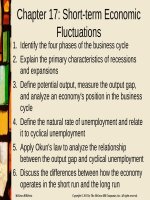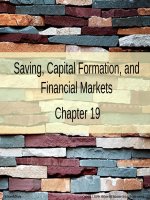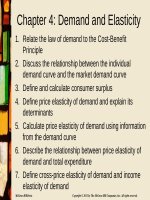Lecture Principles of economics (Asia Global Edition) - Chapter 4
Bạn đang xem bản rút gọn của tài liệu. Xem và tải ngay bản đầy đủ của tài liệu tại đây (807.09 KB, 39 trang )
Elasticity
Chapter 4
McGrawHill/Irwin
Copyright © 2015 by McGrawHill Education (Asia). All rights reserved. 41
The Basics
42
Learning Objectives
1.
2.
3.
4.
5.
Define price elasticity of demand and explain what
determines whether demand is elastic or inelastic
Calculate the price elasticity of demand using
information from the demand curve
Understand how changes in the price of a good
affect total revenue and total expenditure depending
on the price elasticity of demand for the good
Explain the cross-price elasticity of demand and
income elasticity of demand
Discuss the price elasticity of supply, explain what
determines whether supply is elastic or inelastic, and
calculate the price elasticity of supply using
information from a supply curve
43
Drug Enforcement and Local
Theft
•
Hypothesis
–
–
•
Drug users steal to buy drugs
Increasing drug enforcement will decrease theft
Analysis
–
Increased enforcement reduces supply of drugs
•
•
–
Price of drugs increases
Quantity demanded decreases
Theft goes down ONLY IF total expenditure on
drugs decreases
•
How responsive is quantity demanded to price?
44
Price Elasticity of Demand
•
Price elasticity of demand is defined as the
percentage change in quantity demanded from a
1% change in price
–
•
Measure of responsiveness of quantity demanded
to changes in price
Example:
–
–
–
Price of beef decreases 1%
Quantity of beef demanded
increases 2%
Price elasticity of demand is – 2
P
Q
45
Calculate Price Elasticity
•
Symbol for elasticity is ε
–
•
Lower case Greek letter epsilon
For small percentage changes in price
ε=
Percentage change in quantity demanded
Percentage change in price
§
Price elasticity of demand is always negative
§
Ignore the sign
46
Elastic Demand
Price Elasticity of Demand
Unit elastic
Elastic
Inelastic
0
•
1
2
3
If price elasticity is greater than 1, demand is
elastic
–
–
Percentage change in quantity is greater than
percentage change in price
Demand is responsive to price
47
Inelastic Demand
Price Elasticity of Demand
Unit elastic
Elastic
Inelastic
0
•
1
2
3
If price elasticity is less than 1, demand is
inelastic
–
–
Percentage change in quantity is less than
percentage change in price
Quantity demanded is not very responsive to price
48
Unit Elastic Demand
Price Elasticity of Demand
Unit elastic
Elastic
Inelastic
0
•
1
2
3
If price elasticity is 1, demand is unit elastic
–
Price and quantity change by the same percentage
49
Example: Demand for Pizza
Price
Quantity
ε=
Old
$1.00
400
New
$0.97
404
% Change
3%
1%
Percentage change in quantity demanded
Percentage change in price
ε=
1%
3%
= 0.33
Demand is inelastic
410
Determinants of Price Elasticity
of Demand
411
Examples of Elasticities
Green peas
Restaurant meals
Beer
Coffee
Automobiles
2.80
1.63
1.19
0.25
Foreign air travel
1.35
0.77
Movies
Theater, opera
0.87
0.18
412
Taxes And Teen Smoking
•
Hypothesis:
–
Teens’ demand for cigarettes is inelastic
•
•
•
Demand is driven by peers
But, teens also lack income
Analysis:
–
Cigarette taxes increase the price of cigarettes
•
Some teens will smoke less or quit altogether
–
–
These teens will influence others to quit
Higher taxes are likely to reduce teen smoking
413
Unintended Effects of the Yacht
Tax in the U.S.
•
Hypothesis
–
•
Luxury tax on yachts over $100,000 will yield
$31 million in tax revenue
Analysis
–
–
–
Price elasticity of demand is high
Actual tax revenue $16.6 million
People bought yachts outside US to avoid tax
•
•
7,600 jobs in US boating industry lost
Outcome: tax repealed after 2 years
414
Price Elasticity Notation
ε=
Percentage change in quantity demanded
Percentage change in price
•
ΔQ is the change in quantity
–
•
ΔQ / Q is percentage change in quantity
ΔP is change in price
–
ΔP / P is percentage change in price
ε=
ΔQ / Q
ΔP / P
415
Price Elasticity: Graphical View
ΔQ / Q
ΔP / P
ε=
ε=
ε=
ΔQ
x
P
Q
ΔP
P
ΔQ
x
Q
ΔP
P
1
Q
x
slope
Price
ε=
A
P
ΔP
P–ΔP
ΔQ
D
Q+Δ
Q
Quantity
Q
416
Price Elasticity: Graphical View
At point A
P=8
Price
•
Q=3
Slope = 20 / 5 = 4
ε=
P
x
Q
ε=
8
3
1
A
P
ΔP
P–ΔP
ΔQ
D
slope
x
1
4
= 0.67
Q+Δ
Q
Quantity
Q
417
Price Elasticity and Slope
When two demand curves cross
•
•
–
P / Q is same for both curves
(1 / slope) is
1
smaller for the
2
steeper curve
At the common
point demand
is less price elastic
for the steeper
curve
6
Price
•
D
1
Less Elastic
More Elastic
4
D
2
4
6
Quantity
1
2
418
Price Elasticity on a StraightLine Demand Curve
•
Price elasticity is different at each point
ε=
P
Q
–
–
x
1
slope
Slope is the same for the demand curve
P/Q decreases as price goes down and quantity
goes up
419
Price Elasticity Pattern
•
Price elasticity changes systematically as price goes
down
At high P and low Q, P / Q is large
•
•
•
Demand is elastic
At the midpoint,
demand is unit elastic
At low P and high Q,
P / Q is small
•
Demand is
inelastic
a
Price
•
1
1
1
a/
2
b/2
Quantity
b
420
Two Special Cases
Perfectly Elastic
Demand
•
Perfectly Inelastic
Demand
Infinite price elasticity of
demand
Price
•
Zero price elasticity of
demand
Price
D
D
Quantity
Quantity
421
Elasticity and Total Expenditure
•
When price increases, total expenditure can
increase, decrease or remain the same
–
•
The change in expenditure depends on elasticity
Terminology: total expenditure = total revenue
Calculate as P x Q
Graphing idea: total
expenditure is the area
of a rectangle with height P
and width Q
– Example: P = 2 and
Q=4
–
•
Price
Expenditure = 8
2
D
4
Quantity
422
Price Elasticity and Total
Expenditure
Movie ticket price increases from $2 to $4
A and B are both below the midpoint of the curve
Inelastic portion of the demand curve
•
–
Total revenue increases when price increases
12
D
12
Expenditure =
$1,000/day
Price
($/ticket)
–
Price
($/ticket)
•
Quantity (00s of
tickets/day)
5
Expenditure =
$1,600/day
B
4
A
2
D
6
4
6
Quantity (00s of tickets/day)
423
Price Elasticity and Total
Expenditure
Movie ticket price increases from $8 to $10
Prices are both above the midpoint of the curve
•
–
Elastic portion of the demand curve
Total revenue decreases
12
8
Y Expenditure =
$1,600/day
D
2
Quantity (00s of
tickets/day)
6
12
1
0
Z
Price
($/ticket)
–
Price
($/ticket)
•
Expenditure =
$1,000/day
D
1
6
Quantity (00s of
tickets/day)
424
The Effect of a Price Change on
Total Expenditure
Price
$10
$8
$6
$4
$2
$0
Quantity
0
1,000
2,000
3,000
4,000
5,000
6,000
Expenditure
$0
$1,000 $1,600 $1,800 $1,600 $1,000
Total expenditure ($/day)
$12
Price ($/ticket)
1
2
10
8
6
4
2
1
2
3
4
5
Quantity (00s of
tickets/day)
6
$0
1,80
0
1,60
0
1,00
0
2
6
10
Price ($/ticket)
425









